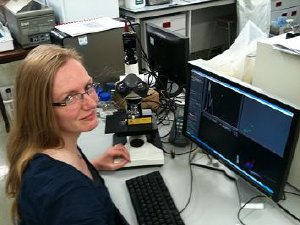Jun 8 2010
The Department of Infection, Immunity and Inflammation at the University of Leicester is using the NanoSight nanoparticle characterization system to count bacteriophage and marine viruses.
 The University of Leicester’s Dr Martha Clokie with her NanoSight LM10 system
The University of Leicester’s Dr Martha Clokie with her NanoSight LM10 system
Dr. Martha Clokie is a lecturer in microbiology. Her interests are focussed on the ecology and molecular biology of bacteriophages and their relationship with bacterial hosts; ranging from bacterial pathogens to environmentally important cyanobacteria; exploiting bacteriophages and phage-derived products as an alternative to treating antibiotic resistant bacterial infections.
Dr. Clokie has been using the NanoSight system to study cyanobacteria and their viruses which involves the accurate enumeration of viral particles. Prior to the use of the NanoSight system, Dr. Clokie would use time-consuming plaque assays to count viruses, this involves relatively large volumes of cyanobacterial culture and takes up to four weeks to obtain results. Now using NanoSight's unique nanoparticle tracking analysis, she is able to produce data in minutes and with no culturing required. Data from the NanoSight appears to correlate well with data from conventional plaque assays. With the typical viruses in the 100-300nm range and marine samples already being in the concentration range of 106 - 107 parts/ml, this is utilizing the sweet spot of the NanoSight technology which tracks and counts light scattered particle by particle.
Of her results to date, Dr. Clokie says it looks to provide a very promising method with significant ease of use, time-saving advantages. "Being able to visualise the sample without dilution gives me confidence in the results. The NanoSight has also shown advantages over flow cytometry where signal to noise issues can sometimes be a problem for us. This speed of data collection will allow me to probe far more data than I could do otherwise and should really allow the cyanobacterial/phage dynamic to be probed."
To learn more about nanoparticle characterization using Nanoparticle Tracking Analysis (NTA), please visit the company's website and register for the latest issue of NanoTrail, the company's electronic newsletter.